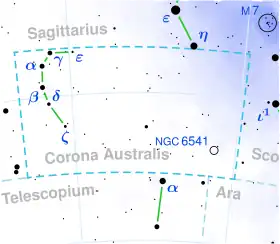 | |
| Observation data Epoch J2000.0 Equinox J2000.0 (ICRS) | |
|---|---|
| Constellation | Corona Australis |
| Right ascension | 18h 31m 02.94877s[1] |
| Declination | −41° 54′ 49.8025″[1] |
| Apparent magnitude (V) | 6.02±0.01[2] |
| Characteristics | |
| Evolutionary stage | main sequence star[3] |
| Spectral type | A3 V[4] |
| B−V color index | +0.14[5] |
| Astrometry | |
| Radial velocity (Rv) | −11.4±0.4[6] km/s |
| Proper motion (μ) | RA: −3.406 mas/yr[1] Dec.: −31.578 mas/yr[1] |
| Parallax (π) | 14.2387 ± 0.0341 mas[1] |
| Distance | 229.1 ± 0.5 ly (70.2 ± 0.2 pc) |
| Absolute magnitude (MV) | +1.86[7] |
| Details | |
| Mass | 2.00[8] M☉ |
| Radius | 1.91±0.10[9] R☉ |
| Luminosity | 16.7+1.1 −1.0[3] L☉ |
| Surface gravity (log g) | 4.19+0.08 −0.07[10] cgs |
| Temperature | 8,694[11] K |
| Metallicity [Fe/H] | −0.01[12] dex |
| Rotation | 19.2 h[13] |
| Rotational velocity (v sin i) | 127±5[13] km/s |
| Age | 544[8] Myr |
| Other designations | |
| Database references | |
| SIMBAD | data |
HD 170384, also known as HR 6931 or rarely 11 G. Coronae Australis, is a solitary white-hued star located in the southern constellation Corona Australis. It has an apparent magnitude of 6.02,[2] making it barely visible to the naked eye, even under ideal conditions. The object is located relatively close at a distance of 229.1 light-years based on Gaia DR3 parallax measurements[1] and it is drifting closer with a heliocentric radial velocity of −11.4 km/s.[6] At its current distance, HD 170384's brightness is diminished by interstellar extinction of 0.28 magnitudes[16] and it has an absolute magnitude of +1.86.[7]
This object has a stellar classification of A3 V, indicating that it is an ordinary A-type main-sequence star. It has double the Sun's mass[8] and 1.91 times the radius of the Sun.[9] It radiates 16.7 times the luminosity of the Sun[3] from its photosphere at an effective temperature of 8,694 K.[11] HD 170384 has a near solar metallicity at [Fe/H] = −0.01 (97% solar)[12] and it is estimated to be 544 million years old,[8] having completed 45% of its main sequence lifetime.[3] Like many hot stars HD 170384 spins rapidly, having a projected rotational velocity of 127 km/s and an estimated rotation period of 19.2 hours.[13]
References
- 1 2 3 4 5 6 Vallenari, A.; et al. (Gaia collaboration) (2023). "Gaia Data Release 3. Summary of the content and survey properties". Astronomy and Astrophysics. 674: A1. arXiv:2208.00211. Bibcode:2023A&A...674A...1G. doi:10.1051/0004-6361/202243940. S2CID 244398875. Gaia DR3 record for this source at VizieR.
- 1 2 Høg, E.; Fabricius, C.; Makarov, V. V.; Urban, S.; Corbin, T.; Wycoff, G.; Bastian, U.; Schwekendiek, P.; Wicenec, A. (March 2000). "The Tycho-2 catalogue of the 2.5 million brightest stars". Astronomy and Astrophysics. 355: L27–L30. Bibcode:2000A&A...355L..27H. ISSN 0004-6361. S2CID 17128864.
- 1 2 3 4 Zorec, J.; Royer, F. (January 2012). "Rotational velocities of A-type stars IV: Evolution of rotational velocities". Astronomy & Astrophysics. 537: A120. arXiv:1201.2052. Bibcode:2012A&A...537A.120Z. doi:10.1051/0004-6361/201117691. eISSN 1432-0746. ISSN 0004-6361. S2CID 55586789.
- ↑ Houk, Nancy (1978). Michigan catalogue of two-dimensional spectral types for the HD stars: Declinations −53° to −40°. Vol. 2. Bibcode:1978mcts.book.....H.
- ↑ Corben, P. M. (April 1971). "Photoelectric Magnitudes and Colours for Bright Southern Stars". Monthly Notes of the Astronomical Society of South Africa. 30 (4): 37. Bibcode:1971MNSSA..30...37C. ISSN 0024-8266.
- 1 2 Gontcharov, G. A. (November 2006). "Pulkovo Compilation of Radial Velocities for 35,495 Hipparcos stars in a common system". Astronomy Letters. 32 (11): 759–771. arXiv:1606.08053. Bibcode:2006AstL...32..759G. doi:10.1134/S1063773706110065. eISSN 1562-6873. ISSN 1063-7737. S2CID 119231169.
- 1 2 Anderson, E.; Francis, Ch. (May 2012). "XHIP: An extended hipparcos compilation". Astronomy Letters. 38 (5): 331–346. arXiv:1108.4971. Bibcode:2012AstL...38..331A. doi:10.1134/S1063773712050015. eISSN 1562-6873. ISSN 1063-7737. S2CID 119257644.
- 1 2 3 4 David, Trevor J.; Hillenbrand, Lynne A. (12 May 2015). "The Ages of Early-type Stars: Strömgren Photometric Methods Calibrated, Validated, Tested, and Applied to Hosts and Prospective Hosts of Directly Imaged Exoplanets". The Astrophysical Journal. 804 (2): 146. arXiv:1501.03154. Bibcode:2015ApJ...804..146D. doi:10.1088/0004-637X/804/2/146. eISSN 1538-4357. S2CID 33401607.
- 1 2 Kervella, P.; Thévenin, F.; Di Folco, E.; Ségransan, D. (October 2004). "The angular sizes of dwarf stars and subgiants". Astronomy & Astrophysics. 426 (1): 297–307. arXiv:astro-ph/0404180. Bibcode:2004A&A...426..297K. doi:10.1051/0004-6361:20035930. eISSN 1432-0746. ISSN 0004-6361.
- ↑ Stassun, Keivan G.; et al. (9 September 2019). "The Revised TESS Input Catalog and Candidate Target List". The Astronomical Journal. 158 (4): 138. arXiv:1905.10694. Bibcode:2019AJ....158..138S. doi:10.3847/1538-3881/ab3467. eISSN 1538-3881. hdl:1721.1/124721. S2CID 166227927.
- 1 2 Balona, L. A. (October 7, 2019). "Evidence for spots on hot stars suggests major revision of stellar physics". Monthly Notices of the Royal Astronomical Society. Oxford University Press (OUP). 490 (2): 2112–2116. arXiv:1910.01584. doi:10.1093/mnras/stz2808. ISSN 0035-8711. S2CID 203642124.
- 1 2 Gontcharov, G. A. (December 2012). "Dependence of kinematics on the age of stars in the solar neighborhood". Astronomy Letters. 38 (12): 771–782. arXiv:1606.08814. Bibcode:2012AstL...38..771G. doi:10.1134/S1063773712120031. eISSN 1562-6873. ISSN 1063-7737. S2CID 118345778.
- 1 2 3 Reiners, A.; Royer, F. (February 2004). "First signatures of strong differential rotation in A-type stars". Astronomy & Astrophysics. 415 (1): 325–329. arXiv:astro-ph/0311341. Bibcode:2004A&A...415..325R. doi:10.1051/0004-6361:20034175. eISSN 1432-0746. ISSN 0004-6361. S2CID 15726297.
- ↑ Gould, Benjamin Apthorp (1878). "Uranometria Argentina : brillantez y posicion de las estrellas fijas, hasta la septima magnitud, comprendidas dentro de cien grados del polo austral : con atlas". Resultados del Observatorio Nacional Argentino. 1. Bibcode:1879RNAO....1.....G.
- ↑ "HD 170384". SIMBAD. Centre de données astronomiques de Strasbourg. Retrieved June 5, 2023.
- ↑ Gontcharov, George A.; Mosenkov, Aleksandr V. (28 September 2017). "Verifying reddening and extinction for Gaia DR1 TGAS main sequence stars". Monthly Notices of the Royal Astronomical Society. 472 (4): 3805–3820. arXiv:1709.01160. Bibcode:2017MNRAS.472.3805G. doi:10.1093/mnras/stx2219. eISSN 1365-2966. ISSN 0035-8711. S2CID 118879856.